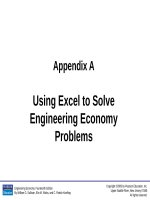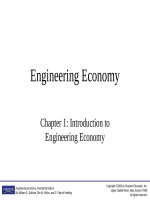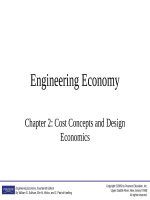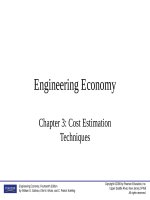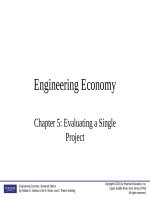Engineering economic 14th by william sullivan and koeling ch 13
Bạn đang xem bản rút gọn của tài liệu. Xem và tải ngay bản đầy đủ của tài liệu tại đây (690.01 KB, 43 trang )
Engineering Economy
Chapter 13: The Capital Budgeting
Process
Engineering Economy, Sixteenth Edition
By William G. Sullivan, Elin M. Wicks, and C. Patrick Koelling
Copyright ©2015 by Pearson Education, Inc.
Upper Saddle River, New Jersey 07458
All rights reserved.
The objective of Chapter 13 is to
give the student an understanding
of the basic components of the
capital budgeting process so that
the important role of the engineer
in this complex and strategic
function will be made clear.
Engineering Economy, Sixteenth Edition
By William G. Sullivan, Elin M. Wicks, and C. Patrick Koelling
Copyright ©2015 by Pearson Education, Inc.
Upper Saddle River, New Jersey 07458
All rights reserved.
Capital financing and allocation
functions are primary components of
capital budgeting.
• Capital financing determines funds needed from
investors and vendors—in the form of additional
stock, bonds, loans—and funds available from
internal sources.
• Capital allocation is where the competing
engineering projects are selected. The total
investment is constrained by decisions made in
capital financing.
Engineering Economy, Sixteenth Edition
By William G. Sullivan, Elin M. Wicks, and C. Patrick Koelling
Copyright ©2015 by Pearson Education, Inc.
Upper Saddle River, New Jersey 07458
All rights reserved.
Engineering Economy, Sixteenth Edition
By William G. Sullivan, Elin M. Wicks, and C. Patrick Koelling
Copyright ©2015 by Pearson Education, Inc.
Upper Saddle River, New Jersey 07458
All rights reserved.
Management must make the decisions
for the financing/allocation connection
• Companies establish the allocation proposal
process.
• Management must select projects that ensure a
reasonable return to investors, to motivate
additional investment when required.
• In summary, these decisions are how much and
where financial resources are obtained and
expended.
Engineering Economy, Sixteenth Edition
By William G. Sullivan, Elin M. Wicks, and C. Patrick Koelling
Copyright ©2015 by Pearson Education, Inc.
Upper Saddle River, New Jersey 07458
All rights reserved.
A company has a variety of sources
available for capital funds. These
sources expect an attractive return.
Average Annual
Return, Rm
Standard Deviation
of Returns
3.8%
4.4%
Long-term U.S. Bonds
5.8
9.4
Corporate Bonds
6.2
8.7
S&P 500 Stocks
12.2
20.5
Small-firm Stocks
16.9
33.2
Type of Security
Treasury Bills
Source: R.G. Ibbotson Associates, Chicago, IL., 2003.
Engineering Economy, Sixteenth Edition
By William G. Sullivan, Elin M. Wicks, and C. Patrick Koelling
Copyright ©2015 by Pearson Education, Inc.
Upper Saddle River, New Jersey 07458
All rights reserved.
Debt capital represents borrowed money.
• Companies can borrow money from lenders (e.g.
banks) or can issue bonds or debentures.
• Creditors get interest, bondholders get dividends
and face value at maturity.
• The cost of bond financing depends on the bond
rating, which is dependent on the financial health
of the company.
• Investors have a risk-free alternative of U.S.
government treasure bills. This risk-free rate of
return is denoted RF.
Engineering Economy, Sixteenth Edition
By William G. Sullivan, Elin M. Wicks, and C. Patrick Koelling
Copyright ©2015 by Pearson Education, Inc.
Upper Saddle River, New Jersey 07458
All rights reserved.
Interest paid on corporate debt is tax
deductible. This savings can be handled
in two different ways.
• Interest can be deducted each year before taxes are
computed. This approach adds more computation,
and it is generally difficult to assign debt payments
to a specific project.
• The most commonly used is to modify the MARR
to account for the tax deductibility of the debt.
• The cost of debt capital is denoted ib.
Engineering Economy, Sixteenth Edition
By William G. Sullivan, Elin M. Wicks, and C. Patrick Koelling
Copyright ©2015 by Pearson Education, Inc.
Upper Saddle River, New Jersey 07458
All rights reserved.
We can reflect the use of a modified
MARR in the equations below.
where
Engineering Economy, Sixteenth Edition
By William G. Sullivan, Elin M. Wicks, and C. Patrick Koelling
Copyright ©2015 by Pearson Education, Inc.
Upper Saddle River, New Jersey 07458
All rights reserved.
Equity capital represents money already
in the firm.
• This can be capital held by stockholders
through company stock.
• It can also be earnings retained by the
company for reinvestment purposes.
• The percentage cost of equity funds, ea, can
be estimated in many ways, perhaps the best
of which is using the capital asset pricing
model (CAPM).
Engineering Economy, Sixteenth Edition
By William G. Sullivan, Elin M. Wicks, and C. Patrick Koelling
Copyright ©2015 by Pearson Education, Inc.
Upper Saddle River, New Jersey 07458
All rights reserved.
The CAPM asserts that the best
combinations of risk and return lie along
the security market line, SML.
Engineering Economy, Sixteenth Edition
By William G. Sullivan, Elin M. Wicks, and C. Patrick Koelling
Copyright ©2015 by Pearson Education, Inc.
Upper Saddle River, New Jersey 07458
All rights reserved.
The CAPM reveals that the return, RS, on
any stock depends on its risk relative to
the market. The risk premium of any
stock is proportional to its beta.
where
Engineering Economy, Sixteenth Edition
By William G. Sullivan, Elin M. Wicks, and C. Patrick Koelling
Copyright ©2015 by Pearson Education, Inc.
Upper Saddle River, New Jersey 07458
All rights reserved.
The graph below illustrates this
relationship.
Engineering Economy, Sixteenth Edition
By William G. Sullivan, Elin M. Wicks, and C. Patrick Koelling
Copyright ©2015 by Pearson Education, Inc.
Upper Saddle River, New Jersey 07458
All rights reserved.
The cost of equity, ea, is estimated as RS.
A company has a beta value of 2.4, with no long
term debt. If the market premium is 8.4%, and the
risk-free rate is 2%, what is the company’s cost of
equity?
so,
Engineering Economy, Sixteenth Edition
By William G. Sullivan, Elin M. Wicks, and C. Patrick Koelling
Copyright ©2015 by Pearson Education, Inc.
Upper Saddle River, New Jersey 07458
All rights reserved.
Pause and solve
Acme has a beta value of 0.7. They have no long-term debt.
What is their cost of equity, based on the Capital Asset
Pricing Model? Use a risk-free rate of 1% and RM = 9.2%.
Engineering Economy, Sixteenth Edition
By William G. Sullivan, Elin M. Wicks, and C. Patrick Koelling
Copyright ©2015 by Pearson Education, Inc.
Upper Saddle River, New Jersey 07458
All rights reserved.
The Weighted Average Cost of Capital
(WACC) represents the average cost of
all funds available to the firm.
Where
Engineering Economy, Sixteenth Edition
By William G. Sullivan, Elin M. Wicks, and C. Patrick Koelling
Copyright ©2015 by Pearson Education, Inc.
Upper Saddle River, New Jersey 07458
All rights reserved.
In the first fiscal quarter of 2009 Dell Computer
showed total debt of $1.98mil and total equity of
$3.55mil. Assume Dell’s beta is 2.2, the cost of debt
is 7%, and Dell’s effective income tax rate is 0.35.
What is the WACC?
Engineering Economy, Sixteenth Edition
By William G. Sullivan, Elin M. Wicks, and C. Patrick Koelling
Copyright ©2015 by Pearson Education, Inc.
Upper Saddle River, New Jersey 07458
All rights reserved.
Each company may have an “optimal”
mix of debt and equity, minimizing the
WACC.
• One task of a company treasurer is to
identify and maintain this mix.
• A constant debt/equity mix is difficult to
maintain over time.
• The separation principle specifies that the
investment decisions (project selection) and
financing decisions should be separated.
Engineering Economy, Sixteenth Edition
By William G. Sullivan, Elin M. Wicks, and C. Patrick Koelling
Copyright ©2015 by Pearson Education, Inc.
Upper Saddle River, New Jersey 07458
All rights reserved.
Establishing the minimum attractive rate
of return (MARR).
• If risks are roughly normal, the WACC is an
appropriate hurdle rate (i.e., MARR).
• WACC is a floor on the MARR, which should be
increased to reflect more risk.
• Management may choose to set the MARR based
on many factors, such as conserving capital in
anticipation of large future opportunities, or
encouraging new ventures. This may also be
differential across divisions.
Engineering Economy, Sixteenth Edition
By William G. Sullivan, Elin M. Wicks, and C. Patrick Koelling
Copyright ©2015 by Pearson Education, Inc.
Upper Saddle River, New Jersey 07458
All rights reserved.
Opportunity costs and MARR
• In this chapter we focus on independent projects.
• The opportunity cost viewpoint is a direct result of
capital rationing, when limited funds are available
for competing proposals.
• Prospective projects (of similar risk) are ranked in
order of profitability. The cut-off point falls such
that the capital is used on the better (more
profitable) projects.
• Firms may set two or more MARR levels,
analyzing within particular risk categories.
Engineering Economy, Sixteenth Edition
By William G. Sullivan, Elin M. Wicks, and C. Patrick Koelling
Copyright ©2015 by Pearson Education, Inc.
Upper Saddle River, New Jersey 07458
All rights reserved.
Establishing the MARR using
prospective project profitability.
Engineering Economy, Sixteenth Edition
By William G. Sullivan, Elin M. Wicks, and C. Patrick Koelling
Copyright ©2015 by Pearson Education, Inc.
Upper Saddle River, New Jersey 07458
All rights reserved.
Selecting projects that are not mutually
exclusive has multiple considerations.
• Those projects that are most profitable should be
selected, allowing for
– intangibles and nonmonetary considerations
– risk considerations
– availability of capital
• In certain cases monetary return is of minor
importance compared to other considerations, and
these require careful judgment.
Engineering Economy, Sixteenth Edition
By William G. Sullivan, Elin M. Wicks, and C. Patrick Koelling
Copyright ©2015 by Pearson Education, Inc.
Upper Saddle River, New Jersey 07458
All rights reserved.
Investment proposals can be classified in
any number of different ways, some of
which are given below.
• Kinds and amounts of
scarce resources used
• Tactical or strategic
• The business activity
involved
• Priority—essential,
necessary, desirable,
or improvement
Engineering Economy, Sixteenth Edition
By William G. Sullivan, Elin M. Wicks, and C. Patrick Koelling
• Type of benefits
expected
• Facility replacement,
facility expansion, or
product improvement.
• The way benefits are
affected by other
proposed projects
Copyright ©2015 by Pearson Education, Inc.
Upper Saddle River, New Jersey 07458
All rights reserved.
There can be many possible degrees of
dependency among projects.
“If the results of the first project would
by the acceptance of the second
project
then the second project is said to be
the first project.”
be technically possible or would result
in benefits only
a prerequisite of
have increased benefits
a complement of
not be affected
independent of
have decreased benefits
a substitute of
be impossible or would result in no
benefits
mutually exclusive with
Engineering Economy, Sixteenth Edition
By William G. Sullivan, Elin M. Wicks, and C. Patrick Koelling
Copyright ©2015 by Pearson Education, Inc.
Upper Saddle River, New Jersey 07458
All rights reserved.
Organizing for capital allocation
• Organizations generally have a formal project
selection process that progresses through the
organizational levels.
• Clearly “good” proposals, or proposals clearly
executing corporate policies, can be approved at
the division level, within certain funding limits.
• Proposals requiring a commitment of a large
amount of funds are sent to higher levels in the
organization (see the table on the next slide).
Engineering Economy, Sixteenth Edition
By William G. Sullivan, Elin M. Wicks, and C. Patrick Koelling
Copyright ©2015 by Pearson Education, Inc.
Upper Saddle River, New Jersey 07458
All rights reserved.




